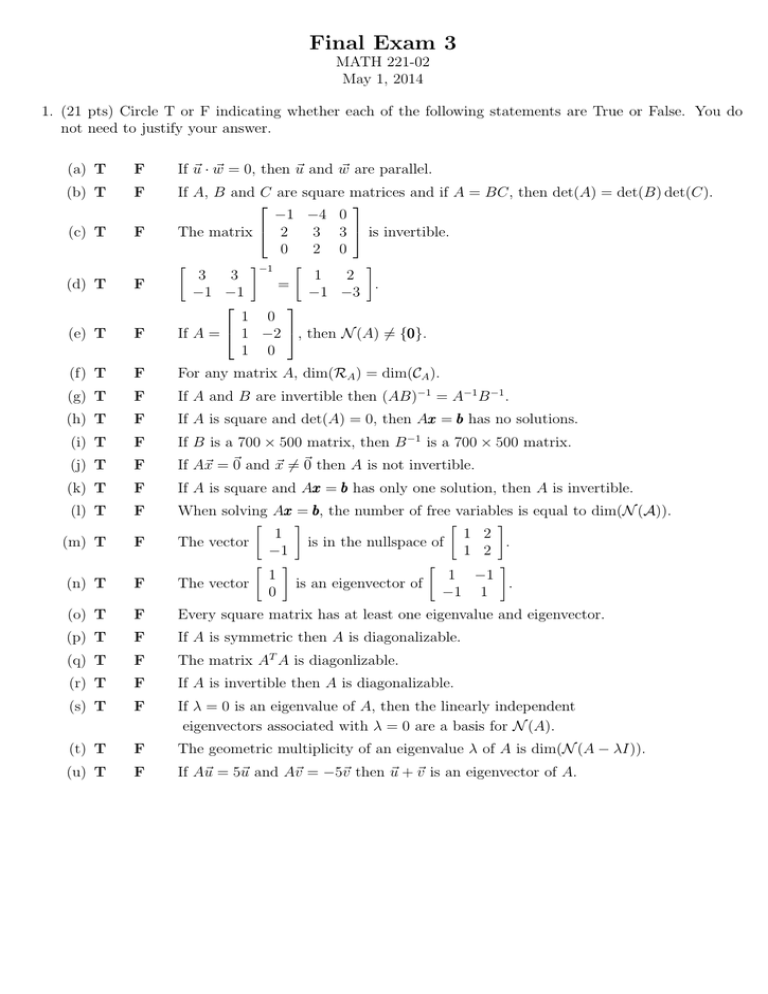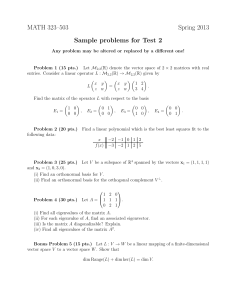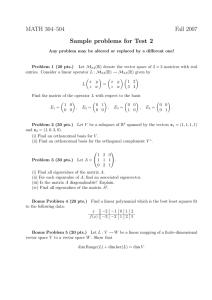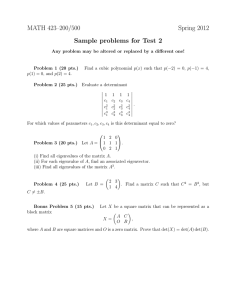Final Exam 3
advertisement

Final Exam 3
MATH 221-02
May 1, 2014
1. (21 pts) Circle T or F indicating whether each of the following statements are True or False. You do
not need to justify your answer.
(a) T
F
If ⃗u · w
⃗ = 0, then ⃗u and w
⃗ are parallel.
(b) T
F
(c) T
F
(d) T
F
(e) T
F
If A, B and C are square matrices and if A = BC, then det(A) = det(B) det(C).
−1 −4 0
3 3 is invertible.
The matrix 2
0
2 0
[
]−1 [
]
3
3
1
2
=
.
−1 −1
−1 −3
1 0
If A = 1 −2 , then N (A) ̸= {00}.
1 0
(f) T
F
For any matrix A, dim(RA ) = dim(CA ).
(g) T
F
If A and B are invertible then (AB)−1 = A−1 B −1 .
(h) T
F
x = b has no solutions.
If A is square and det(A) = 0, then Ax
(i) T
F
(j) T
F
If B is a 700 × 500 matrix, then B −1 is a 700 × 500 matrix.
If A⃗x = ⃗0 and ⃗x ̸= ⃗0 then A is not invertible.
(k) T
F
x = b has only one solution, then A is invertible.
If A is square and Ax
(l) T
F
(m) T
F
(n) T
F
x = b , the number of free variables is equal to dim(N (A)).
When solving Ax
]
]
[
[
1 2
1
.
is in the nullspace of
The vector
1 2
−1
]
[
[ ]
1 −1
1
.
is an eigenvector of
The vector
−1 1
0
(o) T
F
Every square matrix has at least one eigenvalue and eigenvector.
(p) T
F
If A is symmetric then A is diagonalizable.
(q) T
F
The matrix AT A is diagonlizable.
(r) T
F
If A is invertible then A is diagonalizable.
(s) T
F
If λ = 0 is an eigenvalue of A, then the linearly independent
eigenvectors associated with λ = 0 are a basis for N (A).
(t) T
F
The geometric multiplicity of an eigenvalue λ of A is dim(N (A − λI)).
(u) T
F
If A⃗u = 5⃗u and A⃗v = −5⃗v then ⃗u + ⃗v is an eigenvector of A.
2. (12 pts) In each of the following, circle an appropriate statement from the options statement1/statement2.
You do not need to justify your answers.
x = b has no solutions.
Assume that A is n × n and that the matrix system Ax
(a) rank(A) is/(is not) equal to n.
(b) A is invertible/(not invertible).
x = b is consistent/inconsistent.
(c) Ax
(d) det(A) is/(is not) equal to zero.
(e) b is/(is not) a linear combination of the columns of A.
(f) The columns of A are linearly dependent/independent.
x = b has / (does not have) exactly one least squares solution.
(g) Ax
(h) When performing Gauss-Elimination to put the matrix A into row echelon form, there are/(are
not) zero pivot(s).
(i) A has / (does not have) a zero eigenvalue.
(j) A has / (does not have) non-zero homogeneous solutions.
(k) N (A) is/(is not) equal to {00}.
(l) N (AT ) is/(is not) equal to {00}.
ẋ = x + 2y
. SHOW YOUR WORK! Hint: In general, the
ẏ = −2x + y
solution can be written as c1 eλ1 tp 1 + c2 eλ2 tp 2 ; or if appropriate, write solution as
3. (14 pts) Solve the system of ODEs
c1 eαt (aa cos(βt) − b sin(βt)) + c2 eαt (aa cos(βt) + b sin(βt)) .
Also, the quadratic formula might be handy:
√
−b± b2 −4ac
.
2a
.
4. (2 pts) The qualitative behavior of this system is (choose one of A-E):
A. an exponentially increasing function; B. an exponentially decreasing function;
C. an oscillation with decreasing amplitude; D an oscillation with increasing amplitude;
E. An oscillation with constant amplitude.
5. (14 pts) You are solving a system of 5 equations with 3 unknowns. You write out the system as A⃗x = ⃗b.
You applyGauss elimination
to the coefficient matrix A and get the following reduced row echelon form,
1 0 0
0 0 1
rref(A)=
0 0 0 .
0 0 0
0 0 0
Complete the following statements (you do not need to justify your answers):
(a) (1 pt) The dimension of the domain of A is
(b) (1 pt) dim(CA ) =
(c) (1 pt) dim(RA ) =
(d) (1 pt) dim(N (A)) =
(e) (1 pt) dim(N (AT )) =
.
.
.
.
.
x = b is
(f) (2 pts) If b is in CA then the number of solutions to the system Ax
x = b is
(g) (2 pts) If b is not in CA then the number of solutions to Ax
(h) (2 pts) Give a basis for RA .
(i) (3 pts) Give a basis for N (A).
.
.
6. (10 points) The 5 × 5 matrix A has the characteristic equation ρA (λ) = (λ − 3)2 (λ + 4)3 .
(2 points each) The eigenvalues of A are (order them λ1 < λ2 ) (a) λ1 =
and (b) λ2 =
(d)
is (e)
. Their algebraic multiplicities are (c)
,
and
, respectively. A is diagonalizable if the geometric multiplicity of λ1
and the geometric multiplicity of λ2 is (f )
.
7. You collect data on Bozeman water usage in the years 2011, 2012 and 2013 from the facilities that
provide our awesome drinking water. The covariance matrix for these 3 variables (i.e., water usage in
each of the years 2011, 2012 and 2013) is
1 0 0
A = 0 2 0 .
0 0 10
Recall that the 1st row and column of C correspond to the 1st variable, in this case 2011 water usage;
the 2nd row and column correspond to the 2nd variable, 2012 water usage; and the 3rd row and column
correspond to the 3rd variable, 2013 water usage.
(a) (6 pts) Give the eigenvalues of A. SHOW YOUR WORK!
(b) (6 pts) Give the single “best” variable (i.e., the eigenvector that corresponds to the first principle
component) that describes the water usage in 2011, 2012, 2013. SHOW YOUR WORK!
(c) (3 pts) What proportion of the variability on the water usage data from 2011-2013 is explained by
the ”best variable” you found in #7b. SHOW YOUR WORK!
8. A biologist with Montana Fish and Wildlife wants to estimate the number of elk that visit Colby Creek in
the Bridger Mountains. When monitoring the drainage for one 24 hour period, y1 = 5 elk are observed.
When monitoring over a 24 hour period a few weeks later, y2 = 2 elk are observed. And when monitoring
another time, y3 = 10 elk are observed. The biologist wants to fit the “best constant” to the data; that
is, he wants to fit the model
y = c.
x = b to be used to find c? Be sure to identify A, x , and b .
(a) (3 pts) What is the equation Ax
x = b . SHOW YOUR WORK!
(b) (6 pts) Find the least squares solution to Ax





